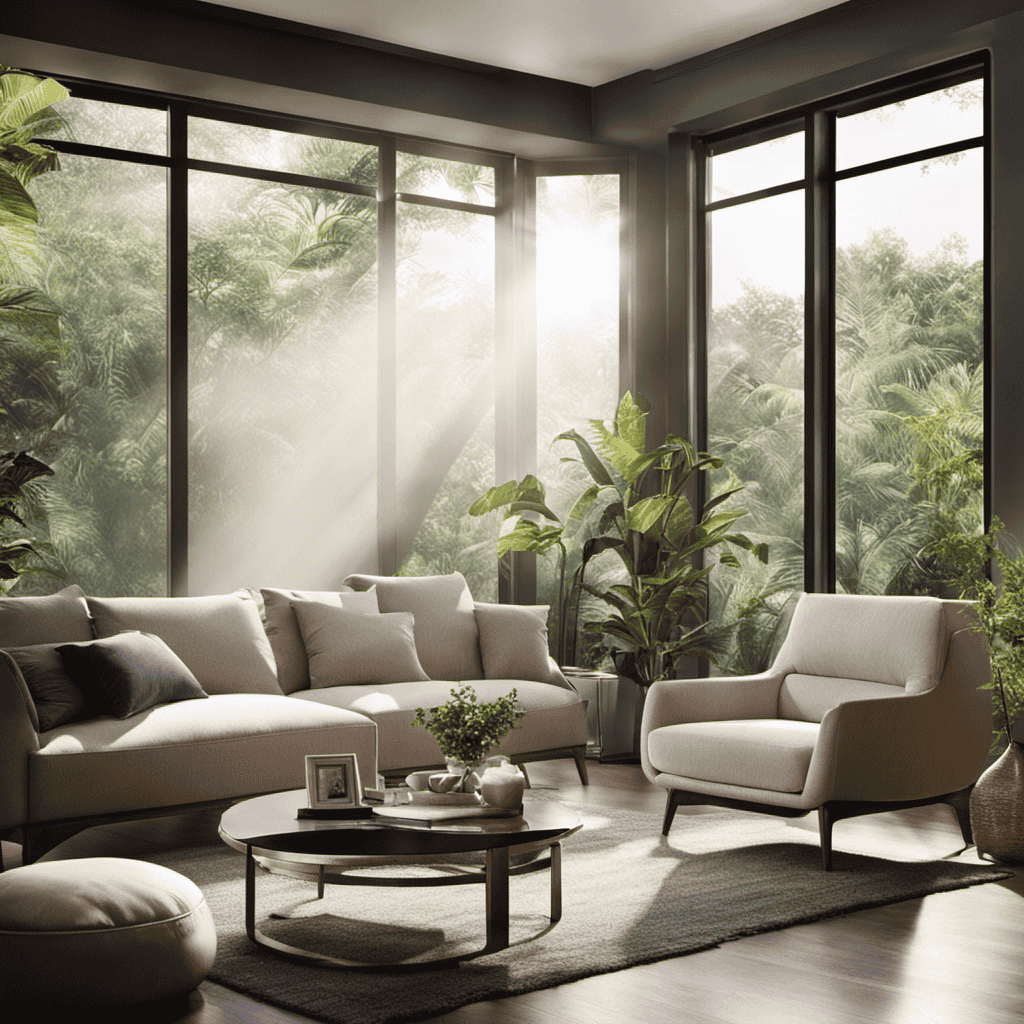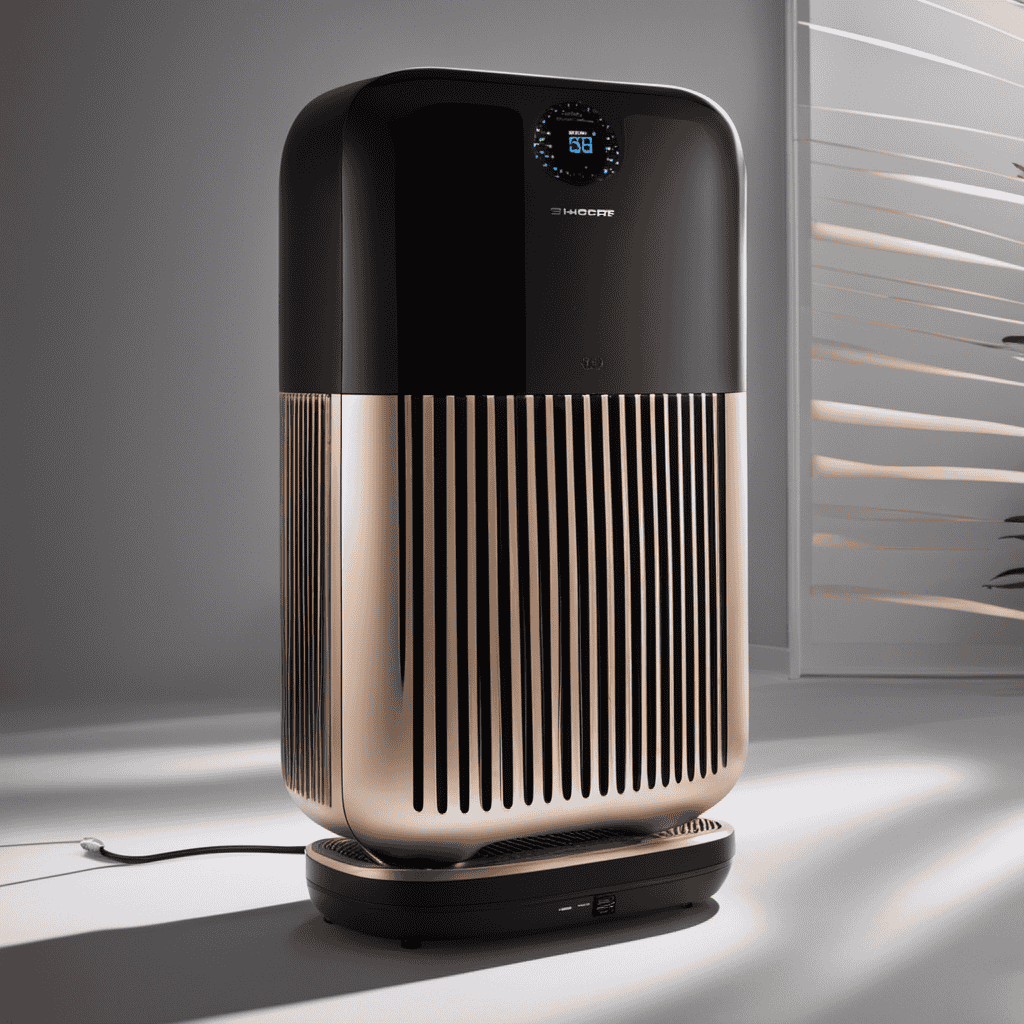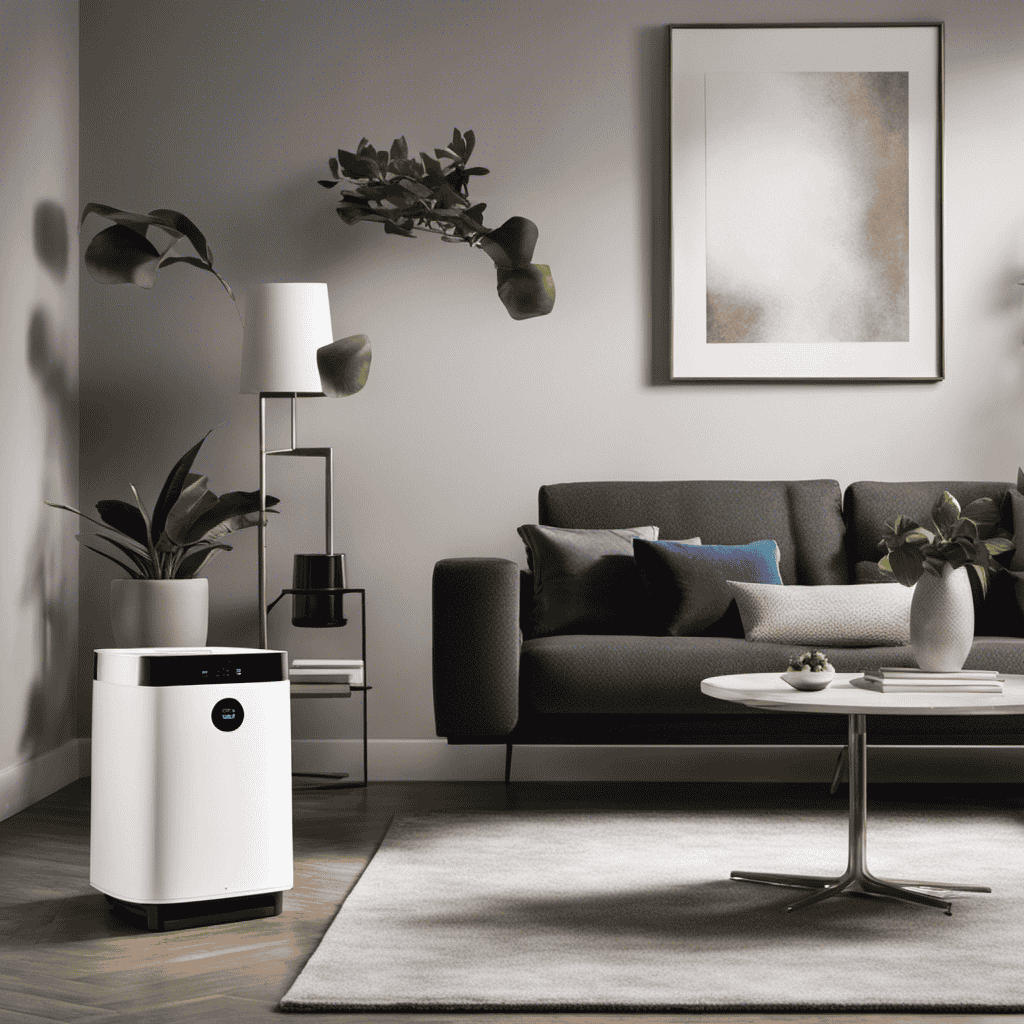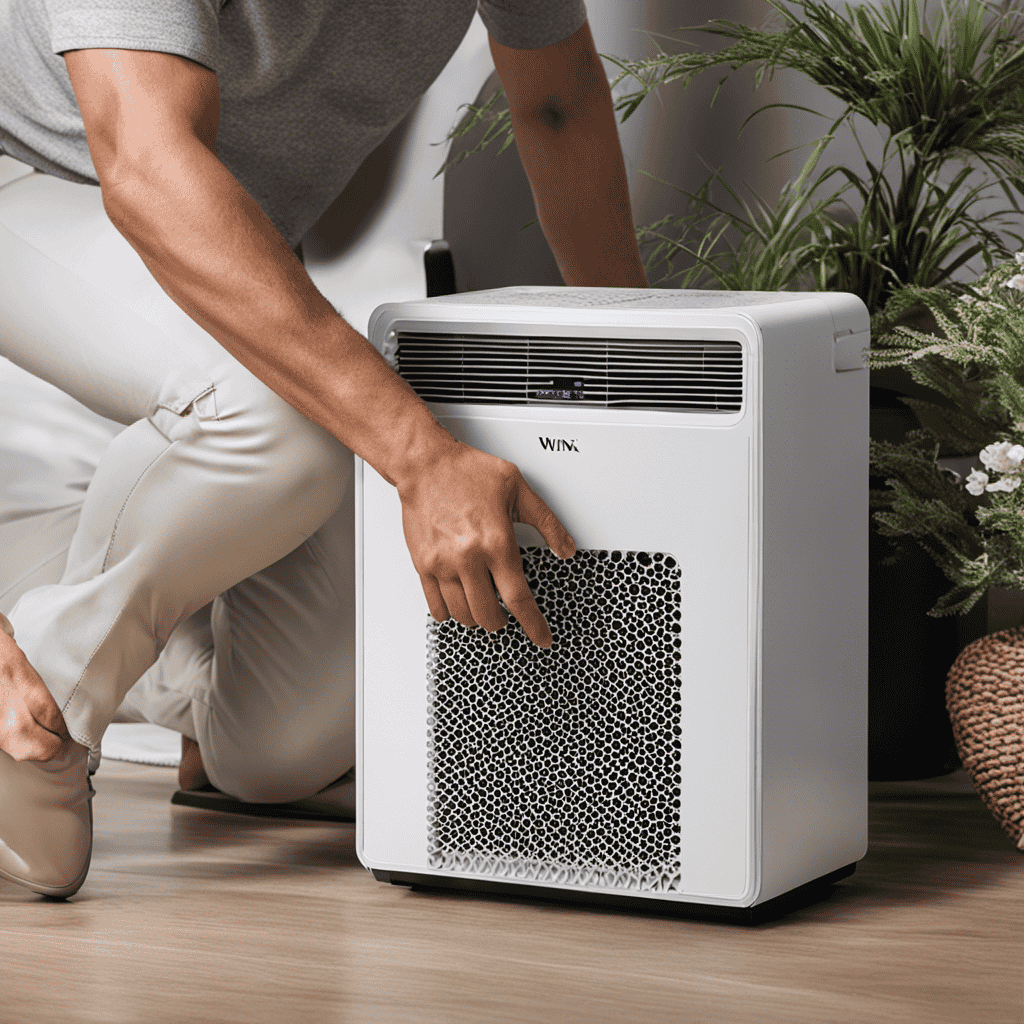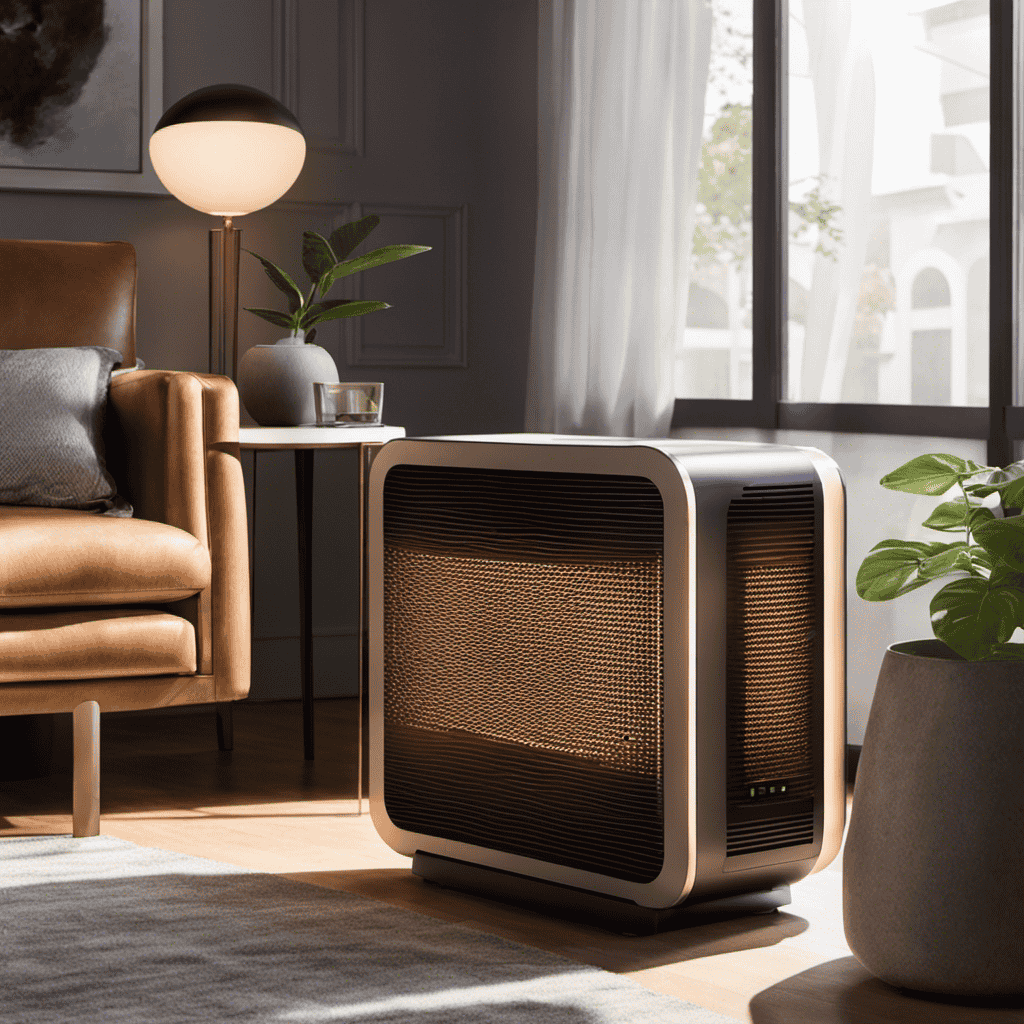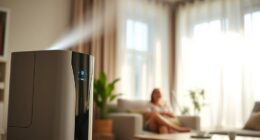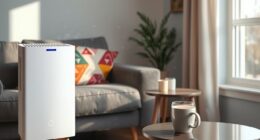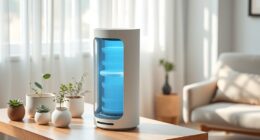When I enter the room, the fresh, clean air immediately catches my attention. It feels like a soft wind is clearing out all the contaminants, creating a haven of freshness.
This is the magic of an air purifier. It works diligently, silently, and efficiently to rid the air of harmful pollutants, allergens, and odors, creating a healthier and more comfortable environment.
In this article, let’s delve into the wonders of air purifiers and uncover what exactly they do.
Key Takeaways
- Air purifiers remove pollutants and impurities from the air.
- They improve indoor air quality and reduce allergy and asthma symptoms.
- Air purifiers cannot eliminate pollutants settled on surfaces.
- Regular maintenance, including cleaning and replacing filters, is crucial for their effectiveness.
How Does an Air Purifier Work
So, how does an air purifier actually work?
Air purifiers are designed to remove pollutants and impurities from the air, improving indoor air quality. They work by pulling in the surrounding air and passing it through a series of filters. These filters capture particles such as dust, pollen, pet dander, and even some bacteria and viruses. The effectiveness of air purifiers depends on the type and quality of the filters used.
HEPA filters, for example, are highly efficient at trapping small particles. However, it is important to note that air purifiers cannot eliminate all pollutants, especially those already settled on surfaces.
As for the cost of operating an air purifier, it varies depending on the model and energy consumption. Some air purifiers require regular filter replacements, which can add to the cost over time.
Benefits of Using an Air Purifier
Using an air purifier can help improve the air quality in your home, making it healthier for you and your family.
Air purifiers are designed to remove harmful particles and pollutants from the air, such as dust, pollen, pet dander, and smoke. By doing so, they can provide a range of health benefits.
Firstly, air purifiers can reduce the symptoms of allergies and asthma by removing allergens and irritants from the air. They can also help to eliminate odors, making your home smell fresher.
Additionally, air purifiers can be cost-effective in the long run. While they may require an initial investment, they can help to prevent respiratory illnesses and reduce the need for medication, which can save you money on healthcare costs.
Overall, using an air purifier can have significant health benefits and be a cost-effective solution for improving the air quality in your home.
Types of Air Pollutants an Air Purifier Can Remove
To maximize the benefits of an air purifier, it’s important to understand the different types of air pollutants it can effectively remove. Indoor and outdoor air pollutants can have detrimental effects on our health.
Indoor pollutants include dust, pet dander, mold spores, and volatile organic compounds (VOCs) emitted from cleaning products and furniture. These pollutants can cause respiratory issues, allergies, and even contribute to the development of asthma.
Outdoor pollutants, such as pollen, smoke, and car exhaust, can also find their way inside our homes and negatively impact our health.
An air purifier with a HEPA filter can effectively remove these pollutants by trapping them in the filter, preventing them from circulating in the air. Additionally, some air purifiers are equipped with activated carbon filters, which can help remove odors and VOCs.
Understanding the different types of air pollutants and how an air purifier can eliminate them is crucial for creating a healthy indoor environment.
Factors to Consider When Choosing an Air Purifier
When choosing an air purifier, you’ll want to consider factors such as room size, noise level, and filter replacement costs. These factors play a crucial role in ensuring that the air purifier effectively improves indoor air quality and reduces allergens that can trigger allergies and asthma.
Here are four key factors to consider:
-
Room Size: The size of the room determines the appropriate air purifier size and capacity needed to effectively clean the air within the space.
-
Noise Level: Consider the noise level of the air purifier, especially if you plan to use it in a bedroom or living area where quiet is essential for a good night’s sleep or relaxation.
-
Filter Replacement Costs: Air purifiers come with different types of filters that need regular replacement. Consider the cost and frequency of filter replacements to ensure long-term affordability.
-
Filter Type: Different filters target specific allergens or pollutants. HEPA filters are highly effective at removing fine particles, while activated carbon filters can remove odors and chemicals.
Tips for Proper Maintenance of an Air Purifier
By regularly cleaning and replacing the filters, you’ll ensure that your air purifier continues to effectively remove allergens and improve indoor air quality.
Air purifier filters play a vital role in trapping and removing airborne particles such as dust, pollen, pet dander, and mold spores. Over time, these filters can become clogged with particles, reducing their efficiency.
To clean them, gently vacuum the filters or rinse them with water, depending on the type of filter you have. It’s important to follow the manufacturer’s instructions for cleaning and replacing filters to maintain the effectiveness of your air purifier. Regular maintenance also extends the lifespan of your purifier.
Now, let’s debunk some common misconceptions about air purifiers.
Common Misconceptions About Air Purifiers
Did you know that air purifiers are not effective in eliminating all types of odors? While air purifiers offer numerous benefits, there are some common misconceptions about their capabilities. Let’s debunk these myths and uncover the truth behind air purifiers.
-
Myth: Air purifiers can eliminate all odors.
Fact: Air purifiers are designed to remove airborne particles, such as dust, pollen, and pet dander. However, they may not be able to completely eliminate strong odors like cooking smells or tobacco smoke. -
Myth: Air purifiers can cure allergies.
Fact: Air purifiers can help alleviate allergy symptoms by reducing the number of allergens in the air. However, they are not a cure for allergies and should be used in conjunction with other allergy management strategies. -
Myth: Air purifiers consume a lot of energy.
Fact: While air purifiers do require electricity to operate, modern models are designed to be energy efficient. Look for ENERGY STAR certified purifiers to ensure energy savings. -
Myth: Air purifiers don’t need regular maintenance.
Fact: Like any other appliance, air purifiers require regular maintenance. This includes cleaning or replacing filters and keeping the unit free from dust and debris.
Understanding the advantages and limitations of air purifiers will help you make an informed decision when it comes to improving your indoor air quality.
Frequently Asked Questions
Can an Air Purifier Eliminate All Types of Odors in the Air?
Yes, an air purifier can eliminate various types of odors in the air. It is effective in scent control and can remove smoke particles, making the air cleaner and fresher.
Can an Air Purifier Prevent the Spread of Airborne Diseases?
Air purifiers can be effective in reducing airborne transmission of diseases like COVID-19. By filtering out particles and contaminants from the air, air purifiers help prevent the spread of airborne diseases.
Can an Air Purifier Help With Asthma and Allergies?
As someone with asthma and allergies, I can attest to the effectiveness of an air purifier. It helps alleviate symptoms by removing allergens and pollutants from the air, making it easier to breathe.
Can an Air Purifier Remove Pet Dander and Pet Hair From the Air?
Yes, an air purifier can remove pet dander and pet hair from the air. Regular air purifier maintenance is necessary to ensure optimal performance. Using an air purifier has many benefits, including improving indoor air quality and reducing allergy symptoms.
Can an Air Purifier Eliminate Harmful Gases Like Carbon Monoxide and Radon?
Air purifiers can’t eliminate harmful gases like carbon monoxide and radon. They are effective in removing airborne particles, but have limitations. Remember, "an ounce of prevention is worth a pound of cure."
Conclusion
In conclusion, an air purifier is like a superhero for your indoor air quality. It swoops in to save the day, capturing and eliminating pesky particles that lurk in the air. With its advanced technology, it leaves behind a refreshing and clean atmosphere. An air purifier tackles everything from allergens to odors, ensuring you can breathe easy. So, don’t wait for the dust bunnies to multiply or the smelly socks to take over. Invest in an air purifier and let it be your trusty sidekick in the battle for fresh air.
